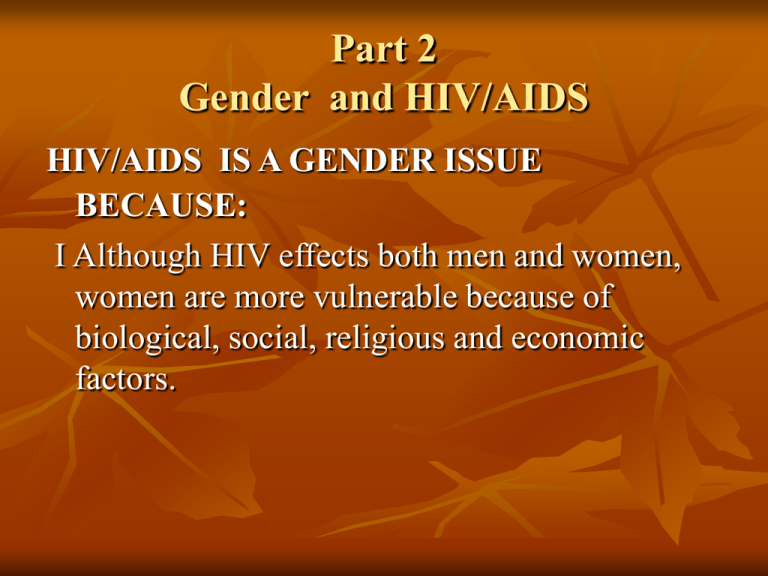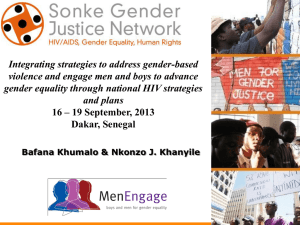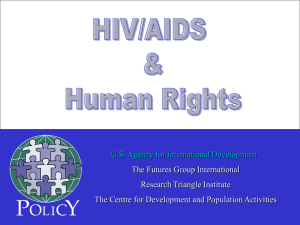
Part 2
Gender and HIV/AIDS
HIV/AIDS IS A GENDER ISSUE
BECAUSE:
I Although HIV effects both men and women,
women are more vulnerable because of
biological, social, religious and economic
factors.
Gender and HIV/AIDS
According to UNAIDS global reports 2010
In 2002, 46% of 33.4 million adults living with
HIV/AIDS were women.
55% of the 16,000 new infections occurring
daily are women.
Gender and HIV/AIDS
A trend observed in some countries the male to
female ratio among HIV infected persons has begun
to equalise.
In fact in some of the worst affected countries,
women outnumber men.
Bottom line:
In sub-Saharan Africa women increasingly make up the
majority of People living with HIV/AIDS.
Gender and HIV/AIDS
What is the number of women living
with HIV/AIDS in your country?
Gender and HIV/AIDS
II The rapidity of the spread of HIV/AIDS
among women can be slowed only if changes
are brought in the sexual behaviour of men.
A behaviour study commissioned by USAID in
India shows that 82% of the male STI patients
had sexual intercourse with multiple partners
within 12 months and only 12 percent had used
a condom.
Gender and HIV/AIDS
A study of female youth in South Africa
showed that 71% of the girls had experienced
sex against their will.
Gender and HIV/AIDS
III feminized poverty and women’s limited
voice in decision-making
Poverty pushes some women into sex industry.
Young girls are particularly vulnerable and
they often have no power to insist on safer sex.
Gender and HIV/AIDS
Lack of education for girls results in low
exposure to HIV/AIDS education messages
due to low literacy rate.
The burden of care for sick family members
falls on women in the family.
GBV and HIV/AIDS
What is the link between HIV/AIDS
and GBV?
GBV and HIV/AIDS
Low power in relationship and intimate partner
violence increase the risk of HIV infection
incident.
Forced sex is correlated to HIV risk.
Survivors of violence tend to engage in
behaviors that put their health at risk.
Proposing condom use may increase women’s
risk of violence.
Disclosing HIV status may increase risk of
violence and abuse.
GBV and HIV/AIDS
Why should Health/HIV
project address GBV?
GBV and HIV/AIDS
GBV is a major cause of death and disability
among women.
Health project can be more effective if it
recognizes reproductive health (RH)
implications of GBV.
Health providers who do not ask about genderbased violence may misdiagnose survivors or
offer inappropriate care.
GBV and HIV/AIDS
Providers may be the first point of contact for
women.
Providers can assist women, rather than
inadvertently putting women at further risk.
Healthcare organizations can raise awareness
of GBV as a public health problem.
GBV and HIV/AIDS
Use a “systems approach,” which entails:
An institutional commitment to GBV
Sexual harassment policies
Patient privacy and confidentiality
GBV and HIV/AIDS
Awareness of local GBV laws
Ongoing training and support for staff
Referral networks to link survivors to legal aid,
counselling, shelters, etc.
GBV and HIV/AIDS
Protocols for the care of survivors.
Emergency supplies such as STI prophylaxis,
post-exposure prophylaxis (PEP), and
emergency contraception (EC), where
supported by the government.
GBV and HIV/AIDS
Educational materials on GBV for clients
Data collection systems
Monitoring and evaluation of quality of care
GBV and HIV/AIDS
How can Health/HIV project address
GBV?
GBV and HIV/AIDS
Support efforts to fully integrate attention
to GBV within existing health programs,
such as
Long-term efforts to sensitize and train health
professionals about GBV;
“Routine screening” or “routine enquiry”
policies ONLY when programs have basic
protections for women; and
GBV and HIV/AIDS
Participation of healthcare organizations in
broader prevention efforts, referral networks,
advocacy campaigns.
Do not duplicate services that already exist.
Health programs should try to identify the
most economically feasible, cost-effective, and
sustainable social services to provide.
GBV and HIV/AIDS
Why should Health Policy project address
GBV?
GBV and HIV/AIDS
Assist in drafting policies and approaches for
the health service response to GBV.
Reframe the policy debate about GBV as a
public health and human rights issue.
Produce and use research on magnitude of
GBV to convince policymakers that
They should address GBV; and
Gaps exist in the legal and civil codes.
GBV and HIV/AIDS
Standardize health sector policies and
appropriate GBV interventions at the
institutional level.
GBV and HIV/AIDS
How can Health Policy project address
GBV?
GBV and HIV/AIDS
Research and dissemination of GBV findings
Public and private coalitions that design and
implement GBV public policy approaches
Efforts to educate key groups and broader
population about GBV as a public health
problem and the linkage to HIV/AIDS
GBV and HIV/AIDS
Why is it important working with
Youth in addressing GBV and
HIV/AIDS?
GBV and HIV/AIDS
Substantial proportions of girls and young
women experience sexual violence around the
world.
Violence by intimate partners often begins
within the first years of dating and marriage.
Sexual abuse in childhood and adolescence has
been linked to numerous poor health
consequences.
GBV and HIV/AIDS
Youth sexual activity is not always voluntary
or consensual.
Youth programs are an ideal opportunity to
further GBV prevention because attitudes
gender and violence are still forming.
GBV and HIV/AIDS
How can Youth work address GBV and
HIV/AIDS?
GBV and HIV/AIDS
Require all reproductive health programming
for youth to address sexual coercion and abuse
Support initiatives that improve family, peer,
and community environments, such as
Efforts to promote gender-equitable norms and
non-violence among young men
GBV and HIV/AIDS
Efforts to empower girls.
Efforts to improve the institutional response to
young survivors of GBV.
Efforts to increase safety of girls and young
women in educational settings.
THANK YOU






